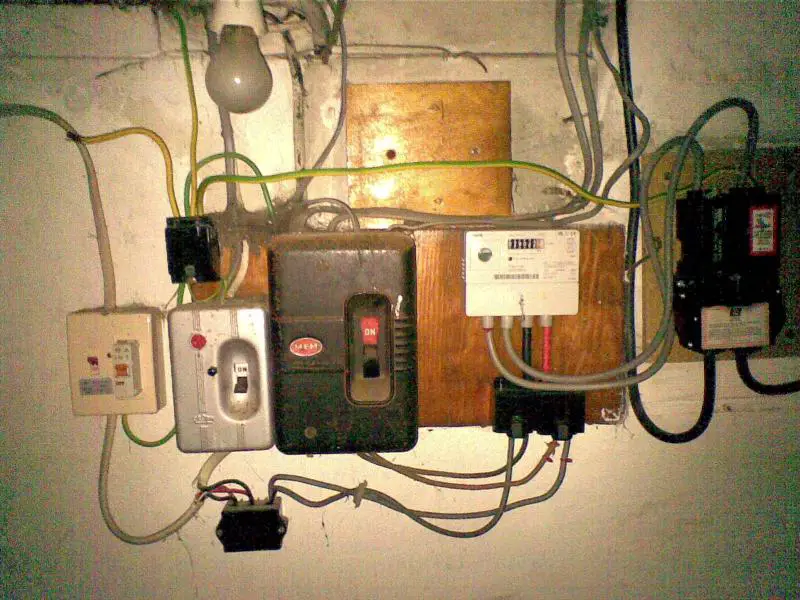You are using an out of date browser. It may not display this or other websites correctly.
You should upgrade or use an alternative browser.
You should upgrade or use an alternative browser.
Unbelievable….No CU
- Thread starter sunsno
- Start date
Sponsored Links
P
Paul_C
Pretty common in older properties. The original MEM unit with four fuses was probably supplemented by the second MEM unit to its left when additions were made later, followed by the very much newer Wylex in much more recent times (quite probably feeding a shower).
There are some rather thin cables hanging off that service fuse...
That the sort of domestic installation I was brought up on. I'm not sure when CUs, as we now know them, first came into being, but I suspect that it was late 60s or early 70s - but very many installations without them persisted for a long time after that.Just been asked to look into doing some work in this flat.
I'm not aware of any regulation which actually compels one to have a CU or DB, in the normal sense. Indeed, in some situations it might still possibly make more sense to have multiple enclosures containing single protective devices!Hey, who needs a Consumer Unit anyway…..???!!!
Kind Regards, John.
Sponsored Links
Interesting.....havent been at this game as long as some of you guys, so it was a new one on me.
Take the point about seperate protective devices, I guess no reason why not when you think about it !
But Ban All Sheds is right, those are cables are way too thin.
Oh well, will keep me busy.
Take the point about seperate protective devices, I guess no reason why not when you think about it !
But Ban All Sheds is right, those are cables are way too thin.
Oh well, will keep me busy.
So all those cables from the cut out, meter, to the henleys, feeding the switch fuses should be capable of pulling 100amps
They should be of a size that will carry enough fault current to operate a 100A fuse should a short circuit occur at the end remote from the fuse!
Which is a whole different thing!
So all those cables from the cut out, meter, to the henleys, feeding the switch fuses should be capable of pulling 100amps
They should be of a size that will carry enough fault current to operate a 100A fuse should a short circuit occur at the end remote from the fuse!
Which is a whole different thing!
Sounds like the same thing to me..!
Ie the fuse should go before the cable melts.
Sounds like the same thing to me..!
Ie the fuse should go before the cable melts.
Fault protection is very different to overload protection but may be provided by the same device.
An overload is an increase in current over the design maximum, which if not prevented would lead to the conductors running above maximum termperature
A fault is a low impedance short between conductors allowing hundreds of amps to flow and is usually over and done with very quickly indeed.
If we protect a cable against overloads its automatically deemed to be protected against faults.... but we might not need overload protection and we might have to calaulcate the cable size for fault protection. Or we might want to use a reduced CSA CPC
nice bit of carpentry
Did you mean to write that? If that really were 'automatically deemed', we presumably wouldn't 'waste our time' measuring Zs or circuits with OPDs (i.e. virtually all circuits), would we? Or am I misunderstanding you?If we protect a cable against overloads its automatically deemed to be protected against faults....
Kind Regards, John.
But that installation hasn't only got single-device units.Take the point about seperate protective devices, I guess no reason why not when you think about it !
And are you not aware that you can still buy, brand new, Wylex Standard Range boards with BS 3036 semi-enclosed fuses, and that:
a) they are still fully compliant with the Wiring Regulations
b) they are called "consumer units".
What point you are trying to make by saying "Hey, who needs a Consumer Unit anyway…..???!!!"?
Sounds like the same thing to me..!

DIYnot Local
Staff member
If you need to find a tradesperson to get your job done, please try our local search below, or if you are doing it yourself you can find suppliers local to you.
Select the supplier or trade you require, enter your location to begin your search.
Please select a service and enter a location to continue...
Are you a trade or supplier? You can create your listing free at DIYnot Local
Sponsored Links
Similar threads
- Replies
- 11
- Views
- 9K



